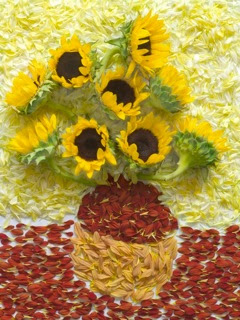When I stumbled upon the Fong Qi Wei's website for Exploded Flowers, it immediately made me think of this multidisciplinary approach to life. Qi Wei is a photographer, apparently living in Singapore. In the Exploded Flowers series, he carefully takes apart a flower and photographs it with all its stems, petals, pistons, and other components spread apart. Here are some examples of his work:
 |
| Copyright © 2011 Fong Qi Wei |
 |
| Copyright © 2011 Fong Qi Wei |
 |
| Copyright © 2011 Fong Qi Wei |
 |
| Copyright © 2011 Fong Qi Wei |
 |
| Copyright © 2011 Fong Qi Wei |
For all of these beautiful photos, or to buy a print or card of one, visit his website here.
I love these, because they are obviously beautiful art. But they also help us learn about science, particularly what exactly goes into a flower. I think it could help us explain to our students the components of the flowers and what pieces perform what functions in the whole plant reproduction process.
However, it also lead to me to math, and the patterns of the petals and other parts. I've written a number of posts about Fibonacci numbers, and my son and I have spent quite a bit of time looking for those Fibonacci sequences in nature. But in real life, it is often hard to tell exactly how many petals there are in a flower, or segments in a pine cone, and such (believe me, we've tried). So actually taking it apart and counting that way--that might be one way to solve the problem. I have to admit, though, that I counted many of the petals in the photographs, and I didn't find too many examples of Fibonacci numbers. But there were lots of interesting patterns to consider, once it was separated enough that you can definitely count different items.
But it doesn't just stop there. Eventually, it occurred to Qi Wei that all those individual petals were similar to individual brush strokes in a painting. So he created several of what he calls "floral paintings" out of petals. For example, consider this one, which was inspired by a woodcut print called The Great Wave off Kanagawa, one of the most famous pieces of Japanese art:
 |
| Veronicas, Hyacinths, Pom Poms, 2011, All Rights Reserved Qi Wei |
I think that is incredible. But I have to admit that my favorite of this series, which mostly reflects Asian art, is one inspired by a Western artist, Van Gogh:
 |
| Van Gogh Sunflower Remix, All Rights Reserved Qi Wei |
So, so lovely and interesting! And so we go from art to nature, and then from nature to art. This makes me really want to go get some flowers and try re-creating some of our favorite paintings in petal form. And thus these pictures extend into Art History, and even Social Studies, as we consider the difference between Asian art and Western art....
That how I think life really is--one topic and/or subject flows into another, which suggests another. I'm just really glad that we can run with that in homeschooling in a way that traditional educational classes can't. But even if your children attend a traditional school, this could be a fantastic project to do with them at home!
No comments:
Post a Comment